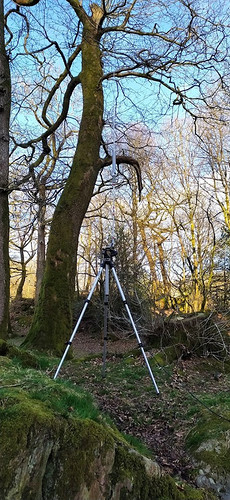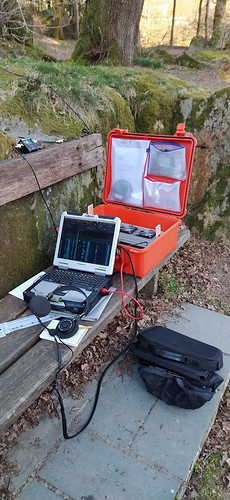Good luck with that in Iceland.
73 Matt
Ok. It seems to me that if the contour lines are too close to interpolate you will have to sit on the summit as the slope will be too steep to stand or sit on without roping yourself to the mountain.
Cheers,
Ron
VK3AFW
A rule is a rule. We’re not going to say “close enough” or “1 metre too low won’t bother anyone”. But we’re not there looking over your shoulders. We’re not routinely checking your GPX uploads against elevation models! But we expect the rules to be followed - full stop. I think that is a perfectly reasonable view that should be shared by all participants. Does that mean we expect you to invest in differential GNSS or whatever? Of course not. I think it is a reasonable expectation that the activator should be confident that he or she is obeying the AZ rule. For another rule such as obeying the power limits set by your licence you wouldn’t just turn a dial to what looks about right, would you. You’d maybe do a calibration of a few dial positions or even carry a portable power meter to be confident.
So please take whatever steps are necessary to be confident you’re within the AZ.
It’s an interesting healthy discussion on this thread. We’ve learnt that:
- Maps aren’t perfect (but they are probably getting better).
- GPS isn’t perfect (consumer grade especially - but perhaps that will improve too)
- Other altimeters might be pretty good for back-tracking from the true summit
- Google Earth definitely isn’t good enough to use blindly (the same will be true with SRTM, &c)
My understanding (probably flawed!) of the military GPS is that it only gains the enhanced chip rate when it has an up to date crypto fill, and defaults to “civvy spec” GPS when it doesn’t. So even if you managed to pinch a military GPS it would only be more accurate until the cyrpto data was superseded?
Table 7. SI prefixes
Factor Name Symbol Factor Name Symbol
101 deca da 10−1 deci d
102 hecto h 10−2 centi c
103 kilo
G4TJC,
What difference is there between “doing the best I can” and “confident”? Confidence can be misplaced especially by the inexperienced. Just my opinion.
73
Ron
VK3AFW
Here in HB9, there are lots of summits where I’m confident that ‘doing the best I can’ leaves me hundreds of metres below the AZ ![]()
73 Jens HB9EKO
Hi Jens,
Haha. In that case you can’t activate. Yes there are many peaks I can’t climb even doing the best I can. However, assuming that we don’t have a failure of communication, if SOTA requires a higher standard than my best then I should retire and take my squid pole fishing.
73
Ron
VK3AFW
Checking my bait box now.
As an example some years ago we noticed an activation of a difficult pillar which obviously can only be climbed by rope work. For 99.9% of activators, I guess, their best effort would not put them in the AZ and would therefore not be valid activations. But there were plenty of other summits available, so just leave those ones for the 0.1% !
The starting theme of this thread was to do with how far you could push to the edge of the AZ in the context of social distancing. That’s nothing to do with how well you can do at accessing the AZ, but rather how far you dare back-track from the true summit. Who would want to go beyond the point of “it’s very likely I’m in the AZ and very unlikely I’ve gone too far”? If I go to the point of “it’s a toss-up” I’m leaving myself open to criticism by my peers and will forever worry if that entry in my activator’s log was a dodgy one.
100% Agreed. After all, we are doing SOTA and not DtbicOTA ![]()
SKIP THIS POST IF YOU DON’T LIKE DIGRESSIONS
Well Phil, my limited experience so far seems to confirm what the reviews I read reported before I made the purchase, i.e. one is trading some performance particularly on the lower frequency HF bands [w.r.t to a well-deployed horizontal wire dipole] for speed of deployment, smaller footprint and ruggedness.
I compared the Cha MPAS Lite [using the supplied single wire counterpoise] against my 60/40/30/20 and 20/10/6 linked dipoles on 4 days at 3 different locations, switching the [KX2] rig antenna input between them, mainly on Rx only.
The vertical’s average performance was 3 to 5 S points down on 60m, -3 on 40m, -2 on 30m, -1 on 20m, and zero on 17m and 15m. Take these numbers with a pinch of salt. The 20m contacts were pan-Europe. I want to repeat the comparisons again over the coming months. It would be interesting to do it when there’s a lift on. I’m wondering how, for example, it varies [if at all] for 20/17/15m for long-haul Dx rather than pan-EU Dx.
The 60ft of wire supplied can be partially wound out as a single counterpoise or used as a long wire antenna instead of the vertical presumably for 80m-40m and NVIS mode [I haven’t tried that yet]. Chameleon also have a counterpoise kit to improve performance but I neither wanted to spend more nor increase the deployment / pack-away time.
Interesting results, many thanks for posting. I bought a 20m hamstick recently to see how it worked mounted on the roof of a vehicle. Today I gave it a try but the SWR was off the scale so in desperation I read the instructions which told me I had to tune it to length first! Once that was sorted (although 2:1 was the best I managed) it was getting dark and 20m was more or less closed. I will try again. 
I’m not surprised. Looking at the Chameleon SWR chart for the HF spectrum, I’d guess that is a “lossy transformer” design. Similar designs, like the Comet CHA-250B, are 6 to 10 dB down from a matched, resonant antenna. That means that 75% to 90% of transmitter power gets turned into heat in the transformer, depending on the band.
An efficient transformer/balun will show very high SWR when the element is not matched and fairly narrow bands of low SWR. A chart with gentle hills and valleys usually means there is resistive loss in the system.
At least Comet is up-front about the design. This is what they say about the transformer:
This is a the “magic” behind the CHA-250B, the transformer matching section.
The transformer on the original CHA-250 had smooth sides. The current version has a heat sink to dissipate heat created inside the transformer.
Yes, some of the RF that enters the power feeding section is turned into heat rather than transmitted as RF, but that is one of the compromises needed to create a broad-band, low SWR, multi-band HF antenna with minimal visual impact.
wunder
I’m new to verticals. As I understand it, when the length of a vertical is less than 1/4-wavelength, the feedpoint becomes capacitive. The loading coil adds inductance to compensate, but this also increases the resistance which making the antenna more lossy.
I wonder what part the ATU is playing in this [which the Cha UG says you should use]. Using the KX2 ATU, I found a VSWR of 1:1.6 on 60m improving to 1:1.0 on 30m and higher-frequency bands. I used a fixed length [~10m] of counterpoise on all bands - I also wonder whether changing it makes much difference.
The Cha MPAS Lite whip is 17ft [~5.2m] long so I would expect it to be resonant about 20m which probably explains why I found its performance seems to be similar to my inverted V 20m dipole. Actually, I noticed listening to many 20m QSOs that some stations were a bit stronger on the dipole, some a bit stronger on the vertical, and some no difference. I wonder if that’s due to the different radiation patterns of the two antennas and the particular path of the incoming signal.
Thanks for the update on your findings so far Andy and my thoughts on how the Chameleon would compare tend to agree with your findings. I would say that band condx and the distance of the station you are receiving or working are probably the deciding “which is best” factor based on the radio wave angles of the signals coming in. It’s well known that a vertical antenna over ground will radiate and receive lower angle signals unless the horizntal dipole you compare it with is several wavelengths high and therefore the Chameleon or indeed any vertical, is likely to be a better performer on the long haul contacts than the dipole - from UK to Asia/Far East, USA/VE, VK/ZL. A vertical or inverted L with a significantly high vertical section versus a shorter horizontal section will most of the time outperform a dipole at a moderate height for DX, but not always, depending on conditions. For working EU from the UK as a SOTA Activator I would tend to favour a mix of the two qualities by using an inverted vee dipole resonant on the chosen frequency set on as high a pole as I am comfortable in carrying - these days usually 5m in length. There are some places with restricted space where a vertical may be your only option, but in this country there aren’ t so many I can think of.
73 Phil
I sat in Rothay Park in Ambleside yesterday, waiting for wife and daughter to finish their run, and was listening to VU2OO working a pileup using the Super Antenna MP1 on 20m. He was 58 with me. I like it in this situation because it has a small footprint compared to a dipole. In this case it was setup on a rock behind the bench I was sat on. With a bit of power into it I’m generally heard (although clearly not above higher power stations in a massive pileup!) I got a stateside contact with WW1X 59 both ways, running 125 watts.
As you might expect 20m and higher frequency bands work better than 40m, which does work but is a little compromised. The 60m and 80m coils add a lot of wire that isn’t in the air. The SOTABeams Band Hopper IV works excellently on 80m and 60m.
The MP1 can be used with a low profile stand and weight can be reduced by restricting bands by not including radials and coils. It allowed me to complete an HF activation of Pike of Blisco that would have been tricky (but not impossible) with my 80m dipole.
Regards, Mark.
Phil, as you know I mainly activate in G/LD and - despite my best efforts to activate at ‘quiet’ times - have sometimes found too many people milling around the summit area to deploy my linked dipole or even my EFHW, and ended up instead activiating only on 2m.
Everyone is understandably weary after 18 months ‘staying local’ and I’m not alone in thinking there’s going to be a post-lockdown explosion of visitors to the countryside [particularly until foreign holidays become possible]. The Lake District hills are going to be more crowded than ever. One motivation for getting the vertical is to occupy a smaller footprint and have quicker set-up & tear-down times especially for the most popular summits. I don’t expect to set any Dx records but I’ve already shown I’ll have no problem qualifying a summit with the Cha MPAS on 30m and 20m with 10W CW.
I’ll still be taking my wire antennas to those summits ignored by most tourists and for events like the SOTA LD weekend.

